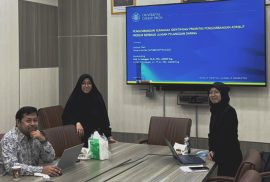Bertha Maya Sopha, Ph.D., Hilya Mudrika Arini, Ph.D., and Sekar Sakti, M.Sc., research team from UGM in partnership with Lancaster University, are conducting research project of The RESilient Emergency Preparedness for Natural Disaster Response through Operational Research (RESPOND-OR). This research project led by the Centre for Transport and Logistics (CENTRAL) at Lancaster University, aims to tackle problems and improve natural disaster emergency preparedness and response. The research team is working closely with key stakeholders representing disaster management organisations in both Indonesia and Sudan. The key stakeholders in Indonesia are Indonesia’s National Disaster Management Authority (BNPB), Disaster Management Agency of the Yogyakarta Special Region (BPBD DIY), and Humanitarian Forum Indonesia (HFI).
The UGM team developed the simulation model for Jakarta flood evacuation to evaluate the effectiveness of the contingency plan with respect to the evacuation time and total number of successful evacuees. The model is developed based on Flood Management Contingency Plan in 2017. The empirical data was collected, and the conceptual model was designed in October 2020 – March 2021. In April 2021, the first version of simulation combines agent-based modelling and discrete-event simulation. The initial simulation model has been presented to BPNB and NGOs in a verification workshop in June 2021. It models the evacuation decision-making of the residents and the evacuation process requiring resources (such as trucks and boats) and evacuation process of people in some neighbourhoods.
The evacuation decision-making was developed based on the empirical studies, whereas the location of shelters and allocation resources was based on the existing contingency plan. Evacuation process is conducted using truck and rubber boat. Trucks are used to evacuate people from the assembly point to the shelter, whilst rubber boats are used to evacuate people who are trapped by flooding in their home (assisted evacuation). The simulation model embeds GIS to represent the actual geographical location of the residents, the assembly points and the shelters. The simulation model dynamically shows the number of arrived residents at each shelters over time (evacuation pattern), the animation of the evacuation, and the used resources over time. The manual for building multi-method simulation for Jakarta flood evacuation can be accessed here.
Source : research team








